In This Issue
-
Jacki Apple ● Leslie Labowitz: Sprout Actions
-
Evgenia Emets ● Eternal Forest
-
Robyn Woolston ● Notes From The Precipice
-
Edie Dillon ● Art & Healing On
Sacred Land -
Zea Morvitz ● Mary Eubank
Artist, Community Nonprofit Gallerist -
Lauren Elder ● Disappearing Hardwoods
-
Mierle Laderman Ukeles ● Touch Sanitation
-
Mary Jo Aagerstoun ● ​​Eco Art and Black Americans’ Relationships to the Land
-
Teresa Camozzi ● Climate Change Dressed In A Fire Gown
-
Ria Vanden Eynde ● Feminist Activist Painting
-
Susan Leibovitz Steinman ● Taking Action
Interview with Leslie Labowitz: Performance, Environmentalism, Feminism, and Politics
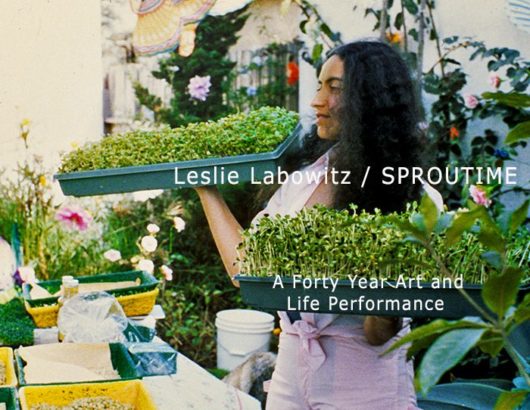
LESLIE LABOWITZ 1980 Photo: Suzanne Lacy
INTRODUCTION
Leslie Labowitz is a seminal Los Angeles feminist performance and visual artist who first became known in the 1970s for her anti-violence against women works in collaboration with Suzanne Lacy. By 1980, with the inception of her forty year art/life project SPROUTIME, she became involved with the ecology of food as both social and personal healing. She began as an urban farmer growing sprouts in her backyard in Venice CA and selling them at local farmers markets. Since then she has created performances and installations while building a business, growing, manufacturing and distributing organic foods throughout Southern California.
Jacki Apple is an Interdisciplinary artist, writer, audio composer, and critic. She is well known for compelling, eloquent essays on interdisciplinary performance (1983-2018). Her current work focuses on environmental issues, climate change, and species extinction. She and Labowitz have had an ongoing exchange of ideas about the interface of art, politics, and life for more than four decades.
APPLE INTERVIEWED LABOWITZ FOR WEAD IN AUGUST 2021
Jacki Apple: At the time I first met you in 1979 you had already produced a number of works that were part of the feminist movement and collaborations with Suzanne Lacy. One of the things I’m interested in understanding is what was the turning point for you. What moved you from those works about violence against women into your involvement with ecological issues and food?
Leslie Labowitz: What happened to me was that as I was very involved in feminist anti-violence art, which I think is really connected to ecology and the environment, but I was not focusing on that aspect of it until 1980. Doing all this violence work was very difficult emotionally. I started looking inside myself for my connections to violence and my connections to my own feminism as I was evolving as a woman in the culture of the 1980s. I got in touch with the realities of growing up as a child of a Holocaust survivor and that has really influenced so much of my life and so many of my choices, whether as an artist or in my personal life. I first considered growing sprouts in 1980 when I began this internal deep search for my own healing, and I turned towards what I could do with the garden; plus the fact that as an artist I needed to make a living. I wanted time to heal and was introduced to a woman who was a member of a co-op and she said I could make a living doing this. At the time I was investigating how sprouting could be turned into a solution for hunger in a lot of countries where there was drought and famine. So the idea of food and hunger became a bigger issue another level other than my own personal healing. It just kind of started working that way. I was impressed that in my Venice yard, in the greenhouse that I had created, I could produce enough product vertically that if there was an earthquake, or some sort of need for food, I could feed all of Venice.
JA: I remember visiting your backyard and it was completely filled with these containers with all these different kinds of sprouts growing….
LL: Yes I created a hanging garden where I grew greens like Alfalfa in the garage. I created space outside where I had buckets with the beans. Then I grew sunflower greens in soil, and buckwheat greens, and wheatgrass, and anything I could grow within that space. I experimented and at one point I was growing maybe thirty different types of beans and seeds and greens just in my yard in Venice. That was really the beginning of opening this door that I never expected given that I was an artist who thought that education was going to be where I ended up, that I would teach and that’s how I would make a living. But suddenly it took over my house!
JA: What was the transition from this concept about healing and the idea of feeding people into an actual performance art work? Where and how did you see this as an art project and a performative one?
LL: The material installation in my backyard represented this movement into life in a different way. As an artist and a feminist I was trying to understand how to move into another level — say taking my feminist consciousness into business. For example I was on the Board of the Farmers Market before it began in Santa Monica. It was the first one. And then how was I going to create a stand that was “performative” — a stand that was a performance artwork as well as a viable business. So in this crossover I was expanding my idea of feminism. I always felt that I was a role model for women, and for other women to do this – to be a mom, business person, and artist. In all of those roles I felt that I was a role model for my own daughter, to show her that she could do all these things. What happened was that what began the 1980s ended up being this long durational live art performance of over forty years. As I look back now I see that it’s been divided into decades, and the 1980s was where my healing and my performance years were. I actually did these performances and installations in museum and gallery sites.
JA: One site of course was at the farmer’s market, and the others were the performances in alternative art spaces. Could you talk a little bit about the SPROUTIME performances in those different locations?
LL: All the performances were titled SPROUTIME which was also the name of my business. The first performance was Mary Mary Quite Contrary How Does Your Garden Grow and that was in my Venice backyard in 1980 where my life as an urban farmer began. As an artist I wanted to take that idea into art spaces around the country as performances.
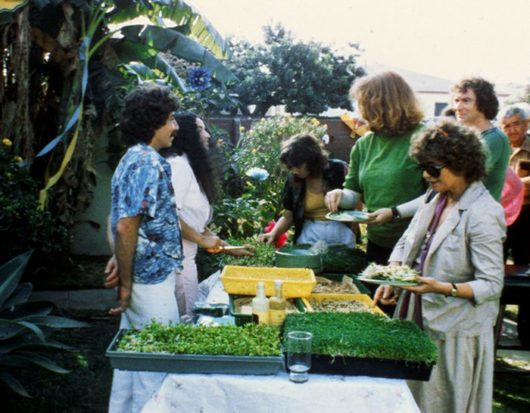
MARY MARY QUITE CONTRARY 1980. Leslie Labowitz’s backyard, Venice, CA.
LL: The performance in New York was called SPROUTIME: A Business for Sale. You (Jacki) were there, and a lot of other friends of ours that you know were there when I actually sold the business. The concept of starting a business, a growing business was part of the installation, part of the performance. It was actually sold to another artist which was my goal, to enable them to find a way to make a living. I sold it to Vanalyn Green for $500 but she never really did it. It was supposed to be a roof garden.
JA: You could have just presented the sprouts and had the sale but there was a much more complex structure to the piece, and a certain poetic aspect as well as a more personal narrative.
LL: New York was very structured and it had a hanging garden. For three weeks I was growing greens in the gallery at the Franklin Furnace and during that time I was doing research in the city of New York to see if it was a viable business. I visited health stores and talked with people and gathered information. Then I also used that as a metaphor to allow me to talk about growing up as a child of a Holocaust survivor, and I did that nude in front of this hanging garden. I used the wheat grass juicer that made green blood as I was talking about how I was born literally maybe ten or twelve months after my mother got out of the camp, not even a year. It was right after she got married. And then at the end I auctioned off the business. I also had Steve Meyerowitz, the Sprout Man of New York, who sang a song and played the piano. What I tried to do was take the heaviness of the Holocaust and turn it into something life-affirming and life-giving, something transformative. I was talking about my internal life but I was also looking at how life regenerates, life goes forward, life keeps on going so that at the end it was also about artist survival. Survival of the artist at that time was a very important thing for me because artists weren’t getting teaching jobs. Artists were not making money and I felt that if an artist could start a business like mine or any other small business that they would not be so dependent on the gallery system or the marketplace. The idea of the artist being a “business” was not embraced. It was like that’s really weird to be in business and be independent of the gallery system.

SPROUTIME: A Business for Sale 1981. Performance/Installation, Franklin Furnace, NYC
JA: But of course given the kind of work you were making it wouldn’t work in a gallery system anyway because of what you’re selling — consumable food. People are buying it and eating it and it doesn’t survive as a commodity beyond that. As a performative act it places the art in a completely different frame. That is the frame of being an interactive experience, a situation in which the viewer or the audience is actually a participant in this transaction….
LL: …and in every performance that I did during the 80s you would eat. It ended with everybody eating sprouts and salads, eating and conversing. So I was feeding the audience as well as engaging in an exchange and a narrative. So you know clearly I wasn’t thinking about selling in the same way.
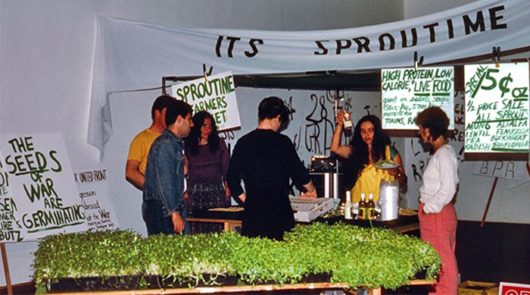
SPROUTIME: A Demonstration 1981 Performance /Installation. SITE Space, San Francisco, CA.
JA: You were just not in any way going to fit into the commodity-based art market. So that’s part of the challenge that we all faced at that time if we were making work outside of that system and it’s a tremendous challenge to not get sucked into that system in order to do that work and continue to evolve in a public context. So aside from the various alternative spaces that you presented works in in the 1980s, there was the Santa Monica Farrners Market which was a kind of public theater if you will.
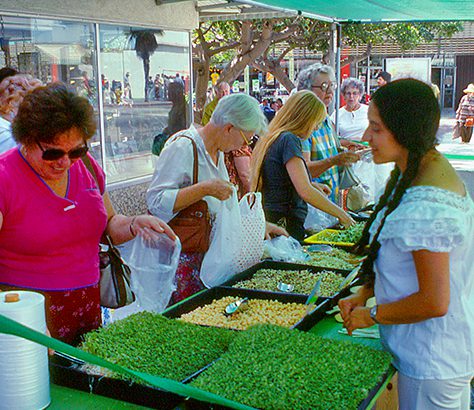
SPROUTIME stand at Santa Monica Farmers Market, 1981.
LL: And each week at the market was essentially a performance, which is how I saw it. As you know Jacki because you worked with me. As did Dark Bob of Bob and Bob, and various other artists. I would engage them in working with me at the stand, and it was a great option for them because they could work for a day or two or three as they chose in their own time.
JA: I loved working at the market with you. I mean it was a performance. It wasn’t simply that I stood there and scooped up sprouts in a plastic bag and handed them to people. There was a dialogue that went on about the sprouts, telling people about them, offering them tastes of things and then also developing recipes.
LL: To go to the last performance in 1989 in my yard. It was when my business had really expanded. It took over the whole yard at that point. I had automated machines and the greenhouse. And I had this wonderful audience.All my peers like you (Jacki), Barbara Smith, Allan Kaprow. And Betty Friedan was there. A long list of everyone I cared about and what I did was present the business. I showed them the machines and I talked about how they worked. Of course I had a sprout display for everybody to eat, including Jacki’s azuki bean chili that was a recipe that we gave out to everybody and was on the menu. That was a really fun experience. I really performed as a business person. Also it was part of Barbara Smith’s series called Commedia dell’Arte that was about artists who did work about food. The nice thing about that time was I could do this in my yard and I could get a bigger audience and it was a great experience. All of the performances of the series she did were performed in people’s homes. I miss that actually. It was very intimate and very personal and expansive creatively. You could try different things out. It didn’t cost a lot of money. It was a very different time.
JA: You also did several art installations around the same time. I remember helping you with the “SPROUTIME: Old Jewish Cemetary” piece at the Long Beach Museum.
LL: Yes I was there in Prague in the 1970s at that old Jewish cemetery that is now a National Monument. It’s based on seven generations of graves buried on top of each other. It also has a small synagogue that was I think one of the first synagogues erected at that time. My ethnic background is Czechoslovakian. Both of my parents were from Czechoslovakia and they were married after the war in that synagogue, and so for me going there was a profound experience on so many levels. When I had the opportunity at the Long Beach Museum in 1984 to make this installation outside I decided to create a version of that Cemetery with my signs that are a takeoff on the protest poster and are also the linguist iconography of my work.

SPROUTIME: Old Jewish Cemetery 1984. Long Beach Museum of Art, CA. Photo: Kira Perov
I had handmade replicas of signs from a hundred years of the anti-war movement by women in this country, and I used those signs as a way to make an anti-war statement. Then they were juxtaposed with signs of how to make sprouts and sprout recipes. Every week one of my employees would bring all the trays of greens and seeds that were already growing, and stack them on the other side of the cemetery so you would see life regenerating. It was a pivotal piece that told the whole story — how I went from the political side of growing to becoming an environmentalist, an eco-feminist. I dedicated it to my mother and my daughter Aria who was born in 1982. It was for the women of the past and the women of the future.
JA: You also did another installation at the18th Street Gallery in the 1990s using an image from the photos I brought you in 1990 from the cemetery in Prague.
LL: I did an installation with stacked greens, beans, seeds that were delivered weekly to create a compost pile that broke down during the six weeks of the show. At the end my employee picked it up and took it back for reuse at my growing facility.

SPROUTIME: Regeneration/Composting 1996. Installation, 18th Street Arts, Santa Monica, CA.
JA: I think it is interesting that you included your employees in your installations in a performative way. Can you elaborate on that a little more? Especially in terms of how your activism and your personal history played out in your relationship with your workers.
LL: In the early 80s I was going to anti-nuclear demonstrations and that was a big part of my thinking about war. I grew up in a family of immigrants, me and my family and all my relatives, so I had a very strong connection to the workers that I had because they were immigrants, mostly from El Salvador and Guatemala. Based on my own past I had a lot of empathy for their situation and I did as much as I could to help them. At that time I could get agricultural Green Cards for them. I was able to get them permanent residencies. Just doing it for six people set off the fact that they could bring their whole families from El Salvador here. Then their kids could become permanent residents. There was a war in El Salvador so I acted again using my own childhood as my pattern. I got them lawyers and went with them to the lawyers. I helped them in the same way that I did with my own parents who couldn’t speak English. At a very early age I needed to be able to correct the spelling and write all those things for them. And so this felt really good, like I was kind of living my mission and that was very inspiring and empowering. Just being around all that greenery and growing things was so life affirming. I really had a very positive outlook on how things were going to go. This movement was evolving, not only my products but the organic movement was growing, the non-GMO movement was growing. So by the time I got to the 1990s I was less focused so much on dealing with my own personal stuff, and I moved much more into the ways in which we can make the planet more sustainable.
JA: Let’s talk more about the eco aspect of what you were doing, how it has evolved in the following decades, and how it intersects with your personal politics and activism as a feminist and environmentalist, as well as an artist.
LL: Referring to my expanding consciousness on the environment and how food plays a part in affecting that environment. Large agribusinesses like Monsanto were taking over the food supply of the world and poisoning us with preservatives. This is one of the main reasons that I was doing what I was doing. Food was being used as a political tool in war all over the world. Food security, which is now such a big issue, was something that was really hitting home to me. How important the system of growing food is, how the food is distributed, who gets the food, and who controls the food is the root of all of our needs. Without food you cannot exist, so how our land, our Earth was being destroyed by not only the pesticides, but the continual use of the same land for the same products was a big issue. The other thing that was really upsetting was the GMOs, how this cloning of different food products was being done, and they were being patented by these big agribusinesses. For example broccoli sprouts that are now very popular because they contain cancer-fighting ingredients called sulforaphane. They [companies] paid for this huge research on the effects of the broccoli seeds and once that was found to be true then one company — it could have been Monsanto I’m not sure — wanted a patent on those seeds so that we sprouters were not allowed to buy those seeds. The Sprout Association had a lawsuit against these big growers and they lost, so we ended up being able to grow broccoli sprouts. Their attempt to own that market failed. Now you just see typical sprouters growing broccoli sprouts, doing what we wanted to do. That’s just the tip of the iceberg. I mean growing sustainably, growing without pesticides, growing in an environment where your workers are not subject to toxic chemicals and protecting them, all of these things were things that I grew into as the business grew up. Knowing how to distribute the product in the safest possible way for people to eat it. There were a multitude of ways in which I moved into the environmental eco world just by doing what I do.
JA: But by the 1990s your business had expanded beyond the confines of your backyard and you became a full-time urban farmer in which the business was the “artwork”.
LL: In the 90s I was focused on building a greenhouse at a space we had moved to in Canoga Park. I bought agricultural property that was 3/4 of an acre because I was cited by the city, because you were not allowed to have a business of this nature in your yard in the city. The property in Canoga Park was the only one I could find in that area that allowed me to have the manager live in the front house and then manage the back after we built out. I had at that point about 30,000 square feet of greenhouse that I was growing in and so my time was spent developing that site, developing how we were going to operate. I leased a manufacturing plant where I would process all this food that I was growing from beans, seeds et cetera into products.

Greenhouse Growing Space 2000, Canoga Park, CA . Photo montage: Jacki Apple.
I created about a hundred different processed foods and sold them to stores and markets all over Southern California. Foodology became the corporate name. At that point I had about sixty employees and two big refrigerated semi trucks and were selling to Trader Joe’s and Costco. Then with the downturn in the economy in 2008 everything just kind of fell into itself and I lost a lot of this business. All small growers like myself who were really providing all the health food stores with delis and so forth, all suffered greatly because Whole Foods started making their own products and they are a big corporate company. So we had to find other marketplaces and I got into edamame that came from China, but I did at the time believe in that product. It’s a soybean and I’m not saying that I still have the same attitude about it. But at that time it seemed right and I ended up being a big supplier of edamame for that market when they got very popular in Japanese restaurants. But by 2011 I was losing business and I ended up having to sell to a larger company where they wanted me to work for them. I ended up doing that for about a year-and-a-half.
JA: I mean that must have been hard. It took it out of the control of your artwork. It was now somebody else’s business in which you were just an employee as opposed to the creator, the person whose value system and ideological and political position was very much at the foundation of this as an artist-generated entity. Then somebody else is now the owner and you’re just an employee. How did that change your whole feeling about it in terms of its relationship to your art?
LL: It was a huge change. It wasn’t so much because of the nature of how I see myself as an artist, which is a constantly evolving being whose life is the material for my work. I did really see this as a stage in finding the art in this. I was hired to run the organic program for them as a director of that program, and one of my goals was to develop a food that would be sold nationally. That was always really important to me to create a national product because mostly what I had been doing was in Southern California. The owner of that company wanted me to do that as well. So I spent most of my time working to create this national product, and I did create a lot of new products for them that they never did.
JA: That must have been very frustrating.
LL: I created what they called Guacamame. It was an edamame-based guacamole and it was fabulous. Trader Joe’s picked it up. But once I left the company, which was soon after the product launch, they were not able to maintain it or keep up the quality, and then Trader Joe’s stop selling it.
JA: So since you left this company you were really in a different position as an artist. I remember you came to my class at Art Center College of Design to do a demonstration and talk about organic food for my Japanese students who were from Tama University. It was part of their Pacific Rim cultural exchange project to do with food, sponsored by the Environmental Design Department, There were teams of students from both Art Center and Tama U. in Japan, and my class was about connecting them culturally to California, to the issues around their design work, and how it connected to other artists working with food. I covered Gordon Matta-Clark’s Food restaurant in New York in the 70s with artists doing the cooking. But you and the Fallen Fruit group were guests who were able to come to the class and actually demonstrate and talk about what you did. You brought the edamame product and everybody sampled it. With the Fallen Fruit group we actually made jars of jam from the fruit they had harvested from public trees.
LL: That was an interesting experience because it was at Art Center where most of the students are going into the commercial world. Again with the kind of consciousness that I operated with it was another opportunity for me to introduce to those students a deeper way of looking at business, and why it’s important to look at the mission of your work, and to be socially-responsible at your work. It was really important to me to remember that. I remember I brought my mother’s shoes from the camp to show them. How do I say this — I believe that food has consciousness and who is making your food, how they’re making your food, what environment they’re making your food in, contributes to the value of all aspects of that food as you consume it.
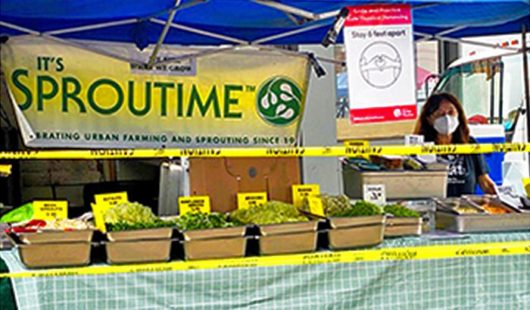
SPROUTIME stand at Santa Monica Farmers Market 2021.
JA: Which brings us into the present moment in a very difficult time. So much has changed since you started out in the 1970s. The climate crisis has accelerated, and we are living in the midst of a pandemic, not to mention the precariousness of the political situation. And it is all interconnected. How has your perspective changed?
LL: In terms of my overall perspective, what I’m working on in terms of the SPROUTIME work which is forty years old, is I’m now putting all the pieces together archivally from the 80s 90s and 2000’s to make one statement. Even though I don’t have a big business anymore I kept my stand at the farmers market as a legacy. I’m probably one of the oldest farmers there from the very beginning in 1980. I started sprouting again in my home and in my daughter’s facility. That’s how I am providing the sprouts for the market again, going back to the beginning where I’m in charge of the sprouting. I am doing it on a very small scale, just for the Santa Monica Market. I don’t see me doing it forever but at the moment, still going through this pandemic, I’m continuing to do it because I do feel that it’s a part of my mission, and I do feel that it contributes to the healing. It’s this very direct contact with consumers about their food, what they eat, how they eat. Through the Covid time it healed me and it also allowed me to help heal others with food and talking about what’s good for the immune system. I find that I’m performing again in that way, even with a mask, even with having to have plastic over everything. So in a sense it’s giving me that affirmation that I was looking for, and as much as it’s hard work, I just cannot imagine me stopping this. I’m turning seventy-five and I can’t quite figure out how long I’m going to do this, but I can’t stop sprouting and I can’t stop turning people on to this way of eating. I still very much believe in it. Sprouts continue to heal me as they heal others, and it is so important to talk about what this year and all the isolation has done to us. The Trump nightmare has been very tough and it’s still tough, but in this very small way if you add water to a seed and it can sprout back, to me that means everything can regrow and renew and become something different. It’s life affirming and that’s what I would hope is the future.
WEAD MAGAZINE ISSUE No. 12, TAKING ACTION
Published October 2021
